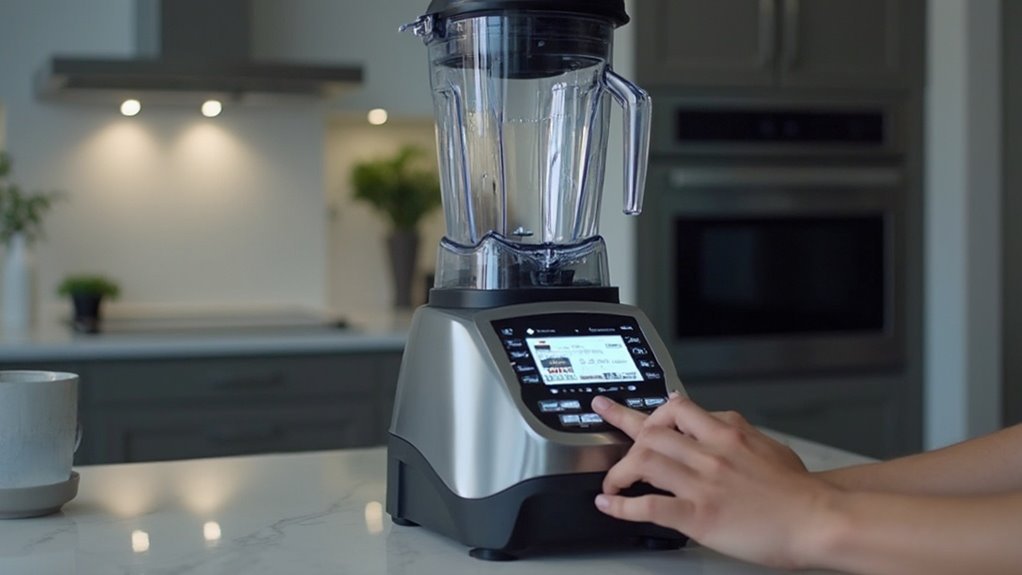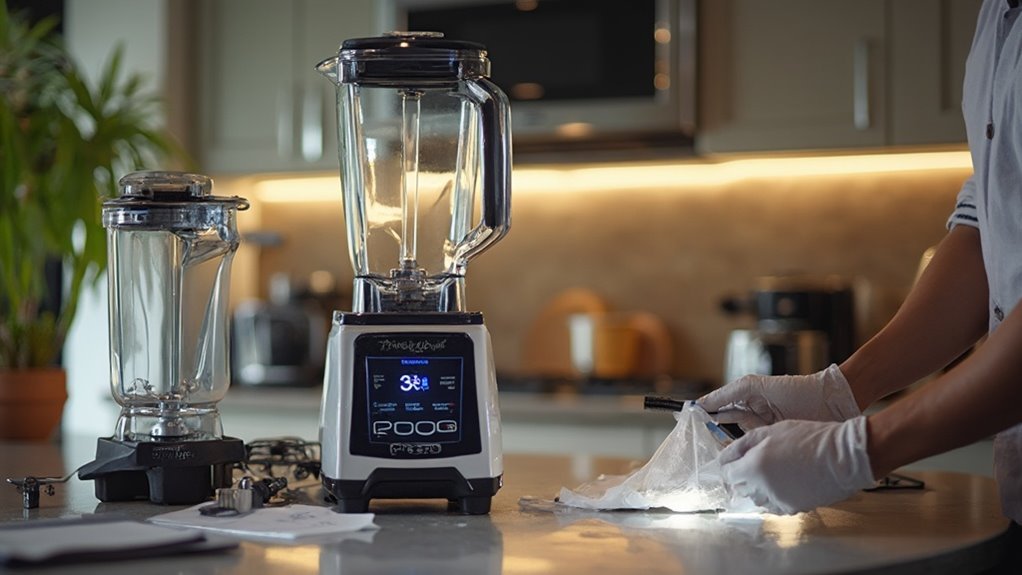To troubleshoot your Ninja blender, start by identifying blinking light patterns as they signal error codes like lid misalignment or motor overheating. Check power connections and outlet functionality using another appliance to guarantee stable performance. Address overheating concerns by allowing cooling time and inspecting blades for wear. If the control panel is unresponsive, inspect and clean it gently. Persistent issues may require professional repair advice. Explore more for deeper insights into resolving these problems efficiently.
Key Takeaways
- Identify blinking light patterns to diagnose specific error codes for troubleshooting Ninja blender issues.
- Verify power supply by checking the power cord, outlet functionality, and voltage stability.
- Allow the blender to cool if rapid blinking indicates motor overheating to prevent damage.
- Regularly clean and inspect the blender for wear, damage, or obstructions to maintain performance.
- Seek professional help for persistent issues after basic troubleshooting, ensuring warranty coverage and certified repair services.
Identifying Common Blinking Light Patterns

When your Ninja blender's lights start blinking, it's crucial to identify the pattern to diagnose the issue accurately. Each blinking pattern corresponds to specific error codes, helping you troubleshoot efficiently.
Identify blinking light patterns on your Ninja blender to troubleshoot issues efficiently and resolve them without professional help.
For instance, if the lights blink alternately, it might indicate a lid misalignment. Confirm the lid is securely locked in place.
A continuous blinking light often signals an improperly installed pitcher, so double-check its placement on the base.
If you encounter a rapid blinking pattern, it could mean the motor is overheating; allow it to cool down.
Understanding these blinking patterns empowers you to resolve minor issues without professional assistance, granting you the freedom to get back to blending.
Understanding Power Supply Issues
First, confirm that the power connections are secure by checking both ends of the power cord and confirming they're firmly plugged into the blender and wall outlet.
Next, verify the outlet's functionality using another device to confirm it's providing power.
Finally, test the power adapter for any visible damage or irregularities in voltage output that might affect the blender's performance.
Checking Power Connections
A crucial first step in troubleshooting your Ninja blender involves inspecting the power connections to guarantee uninterrupted operation.
Begin by examining the power cord for any visible damage, such as fraying or exposed wires, as these can disrupt functionality. Ascertain the power cord is securely connected to both the blender and the wall socket. A loose connection might prevent the blender from receiving adequate power.
Verify that the plug is fully inserted into the wall socket, and confirm that the outlet isn't obstructed by dust or debris, which could interfere with connectivity. If possible, test the wall socket with another appliance to confirm it's providing power.
Addressing these power connection issues can often restore your blender's performance without further intervention.
Inspecting Outlet Functionality
Understanding power supply issues is vital for guaranteeing your Ninja blender operates smoothly. Begin by inspecting the outlet functionality. Test the outlet with another appliance to confirm its working. Make certain the outlet compatibility matches your blender's plug type and voltage requirements. If using an extension cord, verify it's rated for the blender's power. Testing extension cords for damage or improper capacity is important. For better precision, use a multimeter to check the outlet's voltage. This guarantees the power supply is adequate and stable.
| Step | Action | Purpose |
|---|---|---|
| 1 | Test outlet | Confirm functionality |
| 2 | Check outlet compatibility | Match plug and voltage |
| 3 | Inspect extension cord | Verify proper capacity |
| 4 | Measure voltage with multimeter | Verify power stability |
These steps help prevent power-related issues, guaranteeing uninterrupted blending.
Testing Power Adapter
Having confirmed the outlet's integrity and compatibility, the next focus is on the power adapter of your Ninja blender. Verify the power adapter types match your model's requirements. Check for voltage compatibility; mismatched voltages can prevent the blender from functioning.
Use a multimeter to verify the adapter's output voltage aligns with the specified range on the blender's label. Consider the following if issues persist:
- Check for visible damage: Frayed cables or cracks can impair function, jeopardizing both performance and safety.
- Test with another device: Confirm the adapter's efficacy by using it with a known working appliance.
- Replace if necessary: A faulty adapter restricts your freedom to blend at will; invest in a compatible replacement for peak performance.
Addressing these aspects should restore your blender's power.
Addressing Overheating and Safety Features
To tackle overheating in your Ninja blender, start by identifying common causes like overloading or extended use.
Utilize built-in safety mechanisms, such as automatic shut-off features, to prevent damage.
To guarantee longevity, regularly inspect and clean the blender, and avoid operating it continuously beyond recommended durations.
Identifying Overheating Causes
When your Ninja blender overheats, it's important to swiftly identify the underlying causes to prevent damage and guarantee safety.
Overheating signs often include unusual smells, excessive heat, or automatic shut-off. These indicators are significant for recognizing potential issues early.
To address overheating, consider these effective cooling solutions:
- Pause Use: Give your blender time to cool down. This simple act can prevent permanent damage.
- Reduce Load: Blending too much at once increases strain. Opt for smaller batches for smoother operation.
- Check Ventilation: Verify vents are unobstructed. Proper airflow dissipates excess heat, preserving your appliance.
Utilizing Safety Mechanisms
Blenders like the Ninja come equipped with built-in safety mechanisms that actively prevent overheating and guarantee user safety. These features include automatic shut-off and thermal sensors, making certain your blender doesn't overheat or get damaged. To maximize these safety precautions, don't operate the blender for extended periods without breaks. Regularly clean the blades and jar to make sure efficient operation. You can embrace maintenance tips to prolong your blender's life.
| Safety Feature | Function |
|---|---|
| Automatic Shut-off | Stops operation when overheating occurs |
| Thermal Sensors | Detect temperature buildup |
| Locking Mechanism | Prevents operation if not properly sealed |
| Overcurrent Protection | Halts operation if electrical issue detected |
Preventing Future Overheating
Having understood the safety mechanisms, let's focus on preventing future overheating, ensuring your Ninja blender remains reliable and efficient. Following these overheating prevention tips will maximize performance and longevity.
First, maintain ideal airflow by placing the blender on a flat, stable surface away from walls or obstructions, ensuring air can circulate freely. Clean the air vents regularly to avoid dust buildup that restricts airflow.
In addition, avoid overloading the blender. Stick to recommended capacity limits to reduce motor strain. Finally, allow the motor to rest between extended uses. This prevents heat accumulation and extends the appliance's lifespan.
- Maintain ideal airflow: Keep the blender unobstructed.
- Prevent overload: Stick to capacity limits.
- Rest between uses: Prevent heat buildup for longevity.
Fixing Blade and Motor Malfunctions

Experiencing issues with your Ninja blender's blade or motor can be frustrating, but understanding the root causes can lead to effective solutions.
Begin by examining the blade assembly for wear or damage—if it's dull or chipped, a blade replacement is necessary to guarantee efficient blending.
For motor maintenance, unplug the blender and check for obstructions or debris in the motor base. Clean the area thoroughly and make certain that the motor's cooling vents are clear to prevent overheating.
If the motor struggles or emits unusual sounds, inspect for any loose components or signs of electrical damage. Regularly lubricate motor components if recommended by the manufacturer.
Dealing With Unresponsive Control Panels
A multitude of factors can cause the control panel on your Ninja blender to become unresponsive, but pinpointing the issue can lead to straightforward fixes.
Start by performing control panel resets. Unplug the blender, wait 10 seconds, then plug it back in. This simple reset may restore button responsiveness.
If this doesn't work, inspect the buttons for visible debris or damage. Clean the panel gently with a damp cloth, ensuring no moisture seeps inside.
Consider these steps to regain control:
- Frustration: Feeling stuck when your favorite gadget won't cooperate.
- Relief: Experiencing the joy of a quick fix that restores functionality.
- Independence: Mastering your device without professional help.
When to Seek Professional Repair Services
If your Ninja blender continues to malfunction after trying basic troubleshooting steps, it may be time to seek professional repair services.
Before proceeding, check if your blender is still under warranty coverage, as this could greatly reduce repair costs or even offer a free replacement.
Verify if your blender is under warranty to potentially minimize repair expenses or receive a complimentary replacement.
Contact Ninja's customer service to verify warranty status and understand the coverage terms.
If the warranty has expired, weigh the repair costs against purchasing a new unit.
For complex electrical issues or internal component failures, professional expertise guarantees safe and effective resolution.
Don't attempt extensive repairs yourself; it risks further damage or voiding any remaining warranty.
Choose a certified technician to maintain the integrity of your appliance and guarantee peak performance when it's back in action.
Conclusion
You've navigated the intricate dance of diagnosing your Ninja blender's quirks, from deciphering its blinking language to ensuring its power source isn't just playing hard to get. You've handled its overheating whispers and addressed any mechanical hiccups. If the control panel remains aloof, you've considered when to engage the expertise of a professional. With these steps, your blender should return to its culinary symphony, ready to transform ingredients into delightful creations once more.
